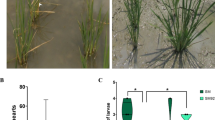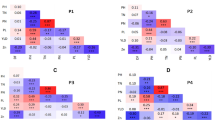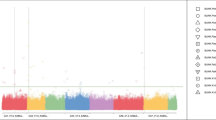Abstract
Rice is a staple food for more than half of the world population but the productivity of rice plant is attenuated in salt-stressed environment. Here 69 diverse rice varieties were evaluated for their salt tolerance capacity. Tolerant and susceptible genotypes were differentiated based on their standard evaluation score and thirteen other physiological parameters. A genome wide 48-SNP markers chip was used to analyze genetic diversity and population structure of the genotypes. Thirteen different salt-responsive candidate genes belonging to different functional categories including transporters, metabolic pathways, intermediate genes and transcription factors were amplified and re-sequenced using Ion Torrent PGM platform. Total 155 SNPs were identified in the selected 13 genes. A candidate gene based association analysis found seven-marker trait associations with five salt tolerance traits. From the 13 genes analyzed, DUF 6 was associated with Na+/K+ ratio, root biomass and root dry weight; SOS 1 with Na+ concentration in leaves and HKT 2;4 with shoot dry weight. This study will be helpful in the development of functional markers associated with salt stress tolerance in rice.


Similar content being viewed by others
Abbreviations
- HKT:
-
High-affinity potassium transporter
- SOS:
-
Salt overly sensitive
- CCC:
-
Cation chloride co-transporter
- SHMT:
-
Serine hydroxymethyltransferase
- DREB:
-
Dehydration responsive element binding
- MLM:
-
Mixed linear model
- SDW:
-
Shoot dry weight
- CDS:
-
Coding DNA sequence
References
Bao JS, Corke H, Sun M (2006) Nucleotide diversity in starch synthase IIa and validation of single nucleotide polymorphisms in relation to starch gelatinization temperature and other physicochemical properties in rice (Oryza sativa L.). Theor Appl Genet 113:1171–1183. https://doi.org/10.1007/s00122-006-0355-6
Bradbury PJ, Zhang Z, Kroon DE, Casstevens TM, RamdossY Buckler ES (2007) TASSEL: software for association mapping of complex traits in diverse samples. Bioinformatics 23:2633–2635
Bray EA (1997) Plant responses to water deficit. Trends Plant Sci 2:48–54
Cotsaftis O, Plett D, Shirley N, Tester M, Hrmova M (2012) A two-staged model of Na + exclusion in rice explained by 3D modeling of HKT transporters and alternative splicing. PLoS ONE 10:39865–39878
FAO (2004) A regional rice strategy for sustainable food security in Asia and the Pacific, Final edition. FAO, Rome
Flowers TJ, Yeo AR (1981) Variability in the resistance of Sodium chloride salinity within rice (Oryza sativa L.) varieties. New Phytol 88:363–373
Garciadeblas B, Senn ME, Banuelos MA, Rodriguez-Navarro A (2003) Sodium transport and HKT transporters: the rice model. Plant J 34:788–801
Gregorio GB, Senadhira D, Mendoza RD (1997) Screening rice for salinity tolerance. IRRI, Discussion Paper Series no. 22. International Rice Research Institute, Manila (Philippines), pp 1–30
Hall TA (1999) BioEdit: a user-friendly biological sequence alignment editor and analysis program for Windows 95/98/NT. Nucl Acids Symp Ser 41:95–98
Henderson IR, Jacobsen SE (2007) Epigenetic inheritance in plants. Nature 447:418–424
Hu H, Dai M, Yao J, Xiao B, Li X, Zhang Q, Xiong L (2006) Overexpressing a NAM, ATAF, and CUC (NAC) transcription factor enhances drought resistance and salt tolerance in rice. Proc Natl Acad Sci USA 103:12987–12992
International Rice Genome Sequencing Project (IRGSP) (2005) The map based sequence of rice genome. Nature 436:793–800. https://doi.org/10.1038/nature03895
Kader MA, Seidel T, Golldack Lindberg S (2006) Expressions of OsHKT1, OsHKT2, and OsVHA are differentially regulated under NaCl stress in salt-sensitive and salt-tolerant rice (Oryza sativa L.) cultivars. J Exp Bot 57:4257–4268
Khush GS, Virk PS (2000) Rice breeding: achievements and future strategies. Crop Improv 27:115–144
Krishnamurthy SL, Sharma K, Kumar V, Tiwari S, Singh NK (2014) Assessment of genetic diversity in rice genotypes for salinity tolerance using Saltol markers of Chromosome 1. Indian J Genet Pl Br 74:243–247
Li H, Handsaker B, Wysoker A, Fennell T, Ruan J et al (2009) 1000 genome project data processing subgroup; the sequence alignment/map format and SAMtools. Bioinformatics 25:2078–2079
Martinez-Gonzalez SC, Huber D, Ersoz E, Davis JM, Neale DB (2008) Association genetics in Pinustaeda L. II. Carbon isotope discrimination. Heredity 101:19–26
McNally KL, Childs KL, Bohnert R, Davidson RM, Zhao K et al (2009) Genome wide SNP variation reveals relationships among landraces and modern varieties of rice. Proc Natl Acad Sci USA 106:12273–12278
Mishra S, Singh B, Misra P, RaiV Singh NK (2016a) Haplotype distribution and association of candidate genes with salt tolerance in Indian wild rice germplasm. Plant Cell Rep 35(11):2295–2308
Mishra S, Singh B, Panda K, Singh BP, Singh N, Misra P, Rai V, Singh NK (2016b) Association of SNP haplotypes of HKT family genes with salt tolerance in Indian wild rice germplasm. Rice 9(1):15
Morello L, Breviario D (2008) Plant spliceosomal introns: not only cut and paste. Curr Genom 9:227–238
Moreno JI, Martín R, Castresana C (2005) Arabidopsis SHMT1, a serine hydroxymethyltransferase that functions in the photorespiratory pathway influences resistance to biotic and abiotic stress. Plant J 41:451–463
Munns R, Tester M (2008) Mechanisms of salinity tolerance. Annu Rev Plant Biol 59:651–681. https://doi.org/10.1146/annurev.arplant.59.032607.092911
Murray MG, Thompson WF (1980) Rapid isolation of high molecular weight DNA. Nucl Acids Res 8:4321–4325
Pandit A, Rai V, Bal S, Shinha S, Kumar V, Chauhan M et al (2010) Combining QTL mapping and transcriptome profiling of bulked RILs for identification of functional polymorphism for salt tolerance genes in rice (Oryza sativa L.). Mol Genet Genom 284:121–136
Pearson GA (1959) Factors influencing salinity of submerged soils and growth of Calororice. Soil Sci 87:198–207
Pritchard JK, Stephens M, Donnelly P (2000) Inference of population structure using multilocus genotype data. Genetics 155:945–959
Ren ZH, Gao JP, Li LG, Cai XL, Huang W et al (2005) A rice quantitative trait locus for salt tolerance encodes a sodium transporter. Nat Genet 37:1141–1146
Rengasamy P (2006) World salinization with emphasis on Australia. J Exp Bot 57:1017–1023
Shannon MC, Rhoades JD, Draper JH, Scardaci SC, Spyres MD (1998) Assessment of salt tolerance in rice cultivars in response to salinity problems in California. Crop Sci 38:394–398
Shi H, Quintero FJ, Pardo JM, Zhu JK (2002) The putative plasma membrane Na+/H+ antiporter SOS1 controls long distance Na+ transport in plants. Plant Cell 14:465–477
Singh N, Choudhury DR, Singh AK, Kumar S, Srinivasan K et al (2013) Comparison of SSR and SNP markers in estimation of genetic diversity and population structure of Indian rice varieties. PLoS ONE 8(12):84136
Singh D, Singh B, Mishra S, Singh AK, Sharma TR, Singh NK (2016) Allelic diversity for salt stress responsive candidate genes among Indian rice landraces. Indian J Biotechnol 15(1):25–33
Singh B, Singh N, Mishra S, Tripathi K, Singh BP, Rai V, Singh AK, Singh NK (2018) Morphological and molecular data reveal three distinct populations of Indian wild rice Oryza rufipogon Griff. Species complex. Front Plant Sci 9:123
Smart R, Bingham GE (1974) Rapid estimates of relative water content. Plant Physiol 53:258–260
Thompson JD, Higgins DG, Gibson TJ (1994) CLUSTAL W: improving the sensitivity of progressive multiple sequence alignment through sequence weighting, position-specific gap penalties and weight matrix choice. Nucl Acids Res 22:4673–4680
Waters S, Gilliham M, Hrmova M (2013) Plant high-affinity potassium (HKT) transporters involved in salinity tolerance: structural insights to probe differences in ion selectivity. Int J Mol Sci 14:7660–7680
Weatherley PE (1950) Studies in water relation of cotton plants. The field measurement of water deficit in leaves. New Phytol 49:81–87
Yu J, Hu S, Wang J, Wong GK, Li S et al (2002) A draft sequence of the rice genome (Oryza sativa L. ssp. indica). Science 296:79–92
Yu JM, Pressoir G, Briggs WH, Bi IV, Yamasaki M, Doebley JF, McMullen MD, Gaut BS, Nielsen DM, Holland JB, Kresovich S, Buckler ES (2006) A unified mixed-model method for association mapping that accounts for multiple levels of relatedness. Nat Genet 38:203–208
Yu X, Bai G, Liu S (2013) Association of candidate genes with drought tolerance traits in diverse perennial ryegrass accessions. J Exp Bot 64:1537–1551
Zeng L, Shannon MC, Grieve CM (2002) Evaluation of salt tolerance in rice genotypes by multiple agronomic parameters. Euphytica 127:235–245
Zhu JK (2003) Regulation of ion homeostasis under salt stress. Curr Opin Plant Biol 6:441–445
Acknowledgements
Authors are grateful for the financial assistance from Indian Council for Agricultural Research under ‘‘Network Project on Transgenic Crops’’. DS is also grateful to fellowship support from the Council of Scientific and Industrial Research, New Delhi.
Author information
Authors and Affiliations
Contributions
DS: design and conduct of experiments, data analysis manuscript preparation BS: collection of landraces, conduct of experiments and manuscript drafting; SM: sequencing, data analysis NKS: planning and supervision of the experiments, and manuscript editing and finalization.
Corresponding author
Ethics declarations
Conflict of interest
The authors declare that they have no conflict of interest.
Electronic supplementary material
Below is the link to the electronic supplementary material.
Rights and permissions
About this article
Cite this article
Singh, D., Singh, B., Mishra, S. et al. Candidate gene based association analysis of salt tolerance in traditional and improved varieties of rice (Oryza sativa L.). J. Plant Biochem. Biotechnol. 28, 76–83 (2019). https://doi.org/10.1007/s13562-018-0464-8
Received:
Accepted:
Published:
Issue Date:
DOI: https://doi.org/10.1007/s13562-018-0464-8




